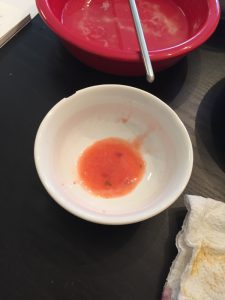Here’s a follow-up experimentation update for the color red. Bonnie and I, Honors students in Dr. Camp’s medieval manuscripts class have been working on re-creating pigments using medieval and modern methods (more details here). Bonnie researched background information and recipes to create yellow, gold and purple. She writes up a review of how making those pigments went in Part 1 of Adventures in Pigment-Making. Meanwhile, I researched red, blue, and green. I’ll be breaking my reviews by color: this one is for red, so be sure to read Part 2.2 (green) and Part 2.3 (blue) as well!
On the whole, I was perhaps most excited for and most disappointed by the color of red. You see, most medieval manuscripts use a bright, vivid red as rubrication because it stood out and made it easy for readers to follow. The most common type of red was made from a toxic element called cinnabar. So, there goes that. With more research, I discovered a resin stone called Dragon’s Blood (what an awesome name!) which the Romans often confused with cinnabar because of how similar the bright red pigments were. Another blog had a beautifully detailed report on her experimentations with Dragon’s blood as well as the history of the pigment. With that I thought “a non-toxic and a pretty red: score!”
 With the mortar and pestle, I ground up a few of the resin stones. They crumbled more quickly under the pressure than I expected. But the finer the powder, the better the pigment! Yet, the color did seem have a duller and more earthlike tone than I expected. Then, I mixed it with equal parts gum arabic and water as the recipe called for. Unfortunately, this is where things started to go awry. Instead of a well-mixed and beautifully bright red pigment, the powdered dragon’s blood and the water simply would not mix! Even after we whisked the mixture as much as possible, it only left a transparent, vaguely red-ish tint when applied to our cotton paper.
With the mortar and pestle, I ground up a few of the resin stones. They crumbled more quickly under the pressure than I expected. But the finer the powder, the better the pigment! Yet, the color did seem have a duller and more earthlike tone than I expected. Then, I mixed it with equal parts gum arabic and water as the recipe called for. Unfortunately, this is where things started to go awry. Instead of a well-mixed and beautifully bright red pigment, the powdered dragon’s blood and the water simply would not mix! Even after we whisked the mixture as much as possible, it only left a transparent, vaguely red-ish tint when applied to our cotton paper.
So, of course, we tried with the other types of binders (egg yolk and egg white). Egg yolk provided some base of color for the dragon’s blood powder to stand out, yet was still a muddled red rather than the bright red that seemed so beautiful in all the codices and fragments we have been looking at from the Hargrett Rare Book and Manuscript Library.
While it seemed the color might not be as strong as I would hope, I didn’t want to give up yet. I returned to the wonderful internet for a solution and found that adding isopropyl alcohol might do the trick since resins do not dissolve in water. Thus, we added some drops of alcohol to the powdered dragon’s stone and saw a nice opaque and rich red, but it quickly gummed up into a clay-like substance that could not be used as a paint.
So alas, we finally gave up on dragon’s blood.

We turned our eyes to another way to create red pigment: strawberries! This process was straightforward, as all we had to do was mash strawberries with a fork or muddler to get the red juice that I’m sure we’ve all had stain our fingers a time or two. My biggest concern for this pigment was how to thicken it from the thin fruit juice we’d just made.
We obviously combined the strawberry juice with both egg yolk, egg white, and gum arabic. The egg yolk provided the richest red color, but still turned pink and faint when used to paint. Likewise, the egg white made an even more transparent color, as did the gum arabic.
Thinking perhaps the color was fading out because of how thin the pigment was, I foolishly thought that perhaps flour, or cornstarch, or baking soda and baking powder for what it’s worth might make a thicker pigment! I suppose I can’t be too surprised that none of those really worked, though it was interesting to see how the whiteness of the powders actually lightened the color of the strawberry juice. So really the opposite of what I had desired.
Just like that, another pigment bites the dust.